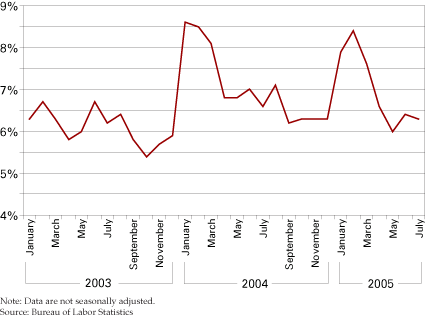Terre Haute
Indiana State University, Terre Haute
After decades of steady decline, the Terre Haute economic horizon has noticeable signs of economic progress but a few lingering clouds. The demolition of the city’s iconic Terre Haute House, a retail construction boom, and a significant expansion at Aisin Brake suggest a new economic vitality to the city. Still, the uncertain future of Sony’s Blu-ray technology for the high definition home movie market, the uncertain future of Pfizer’s yet-to-be approved inhaled insulin, and the almost certain total closure of Columbia House prevent unbridled enthusiasm.
As 2005 opened, Mayor Kevin Burke announced the city had secured an option on the Terre Haute House. The hotel, closed since the early 1970s, was an icon for many. Those who loved its Mayflower Room considered it a potential cornerstone to a revitalized downtown, while others viewed it as a symbol of the city’s inability to move forward. By April, several plans had been submitted but none were judged by the city to have sufficient financial backing to succeed. By fall, the Hulman family sold the building to Terre Haute’s Greg Gibson for $1 and demolition began shortly thereafter. Amid demolition came the November announcement of plans for a new “Hilton Garden Inn—Terre Haute House” to open in the summer of 2007.
Also in 2005, retail construction began a boom not seen in the city for decades. South of the existing Wal-Mart Supercenter, construction began on a retail complex that will ultimately include a Kohl’s, a TJ Maxx, and several small stores and restaurants. Meanwhile, construction of a new Wal-Mart Supercenter on the east side of the city (near the I‑70–Indiana 46 interchange) promises to bring a significant expansion of retail activity. Several other smaller construction endeavors also significantly upgraded the retail options in the city.
It is not entirely clear that there will be good-paying jobs to support these new retail ventures. Though Aisin Brake announced a significant planned expansion of its workforce during the year, the BMG purchase of Columbia House makes it all but certain that one of the city’s former employment mainstays will ultimately abandon its Terre Haute northeast location. As shown in Figure 1, the city’s unemployment rate jumped markedly in early 2004 and 2005 with Columbia House job-cut announcements. Each time it has returned near its previous levels.
Figure 1
Terre Haute Unemployment Rate

In 2006, two decisions—one made by the Food and Drug Administration (FDA) and one made by movie studios and consumers worldwide—will provide significant clarity for Terre Haute’s economic future. The FDA stands ready to approve Pfizer’s inhaled insulin. Terre Haute’s southside Pfizer plant would likely manufacture much of these delivery systems, adding significant jobs in the process. On the other end of the city, Terre Haute’s northside Sony plant stands ready to produce a significant portion of the high definition movies that will be sold throughout the world. The uncertainty here is that Sony’s Blu‑ray technology is incompatible with Toshiba’s HD DVD and a BetaMax vs. VHS type war is likely in the offing. If Blu‑ray wins, so will Terre Haute.
Also in this Issue…



